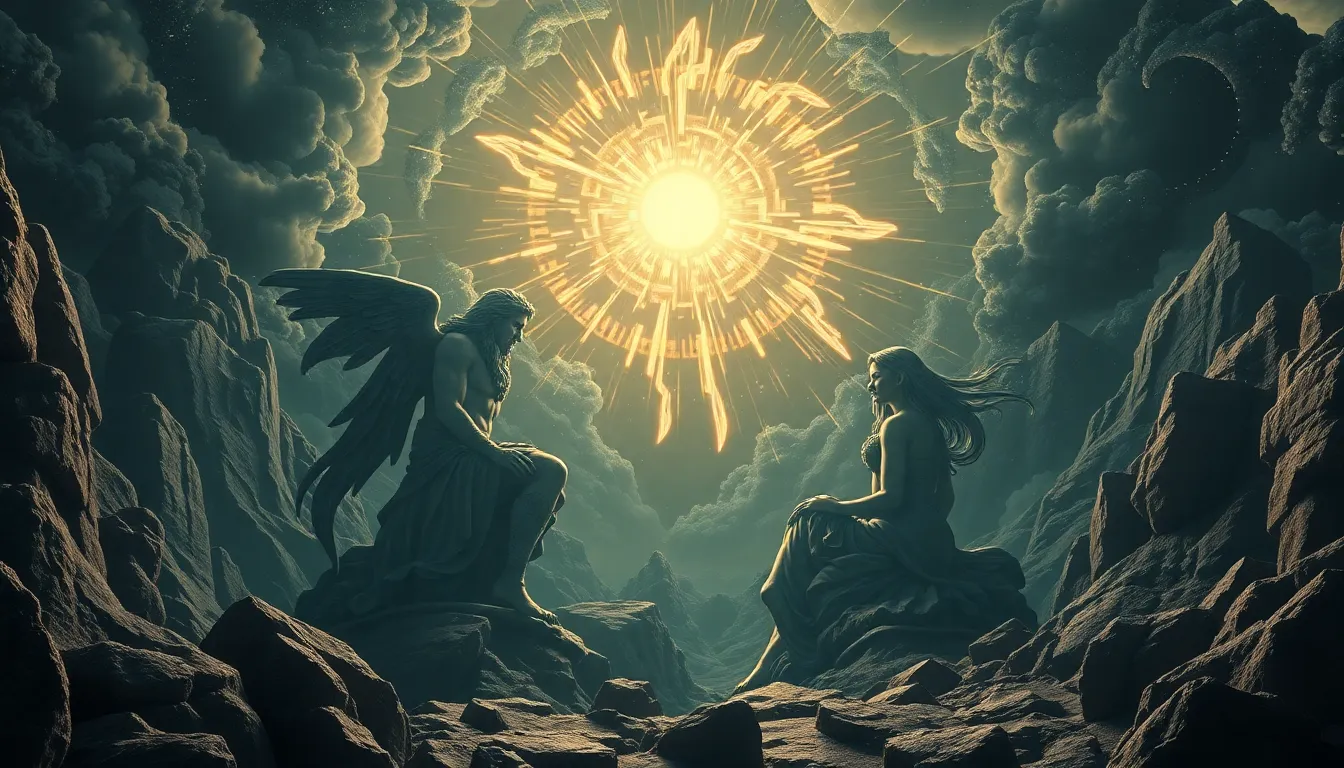Uranus and Gaia: The Divine Duo Behind Creation
I. Introduction
In the rich tapestry of Greek mythology, Uranus and Gaia stand as monumental figures representing the primordial forces of the universe. Uranus, the personification of the sky, and Gaia, the embodiment of the Earth, are fundamental to the creation stories that shape our understanding of existence. Their roles are not merely as deities but as essential creators who laid the groundwork for life and the cosmos as we know it. This article delves into their mythological backgrounds, their relationship, their contributions to creation myths, and their enduring legacy in both ancient and modern contexts.
II. Mythological Background of Uranus and Gaia
Uranus and Gaia originate from the earliest moments of Greek mythology. According to Hesiod’s “Theogony,” they emerged from Chaos, the primordial void. Their existence marks the beginning of the cosmos, with Uranus representing the overarching sky that envelops the Earth, Gaia.
Uranus is often depicted as the starry sky, a vast expanse that not only covers but also nurtures the Earth. In contrast, Gaia is portrayed as a nurturing figure, the fertile ground that gives rise to all life. Together, they symbolize the essential duality of nature, where the sky meets the earth, fostering the growth of all living beings.
III. The Relationship Between Uranus and Gaia
The union of Uranus and Gaia resulted in the birth of numerous primordial beings and entities crucial to Greek mythology. Together, they parented the Titans, the Cyclopes, and the Hecatoncheires, among others. This family dynamic is vital to understanding the balance of cosmic forces in mythology.
- Creation of the Titans: The Titans were powerful deities who ruled during the Golden Age of mythology.
- Birth of Cyclopes: One-eyed giants who were skilled craftsmen, contributing to the creation of divine weapons.
- Hecatoncheires: The hundred-handed giants who personified brute strength.
Their union is significant not only for the creation of these beings but also for establishing a cosmic order that would govern the universe. However, the dynamics of their relationship would also lead to conflict, setting the stage for further mythological narratives.
IV. Uranus and Gaia in Creation Myths
Uranus and Gaia’s contributions to creation myths are profound. Their partnership symbolizes the harmony required for creation to occur. Together, they brought forth the universe, setting into motion the cycles of life, death, and rebirth.
Their descendants play pivotal roles in mythological narratives, often becoming central figures in tales of heroism and tragedy. For instance, the Titans, who were born of Uranus and Gaia, would eventually challenge the Olympian gods in a struggle for power.
- Symbolism of their partnership: Their union represents the balance between opposing forces: the sky and the earth, male and female, creation and destruction.
- Contribution to the natural world: They embody the fundamental elements of nature, influencing seasons, fertility, and the cycles of the moon and sun.
V. The Conflict Between Uranus and Gaia
Despite their foundational role in creation, the relationship between Uranus and Gaia was not without strife. Uranus’s tyranny over their offspring led to significant conflict. He feared their power and, in an effort to maintain control, imprisoned many of his children within Gaia.
In response, Gaia, feeling betrayed and angered, devised a plan to overthrow Uranus. She bore a child, Cronus, and equipped him with a sickle to castrate Uranus, thus ending his reign of terror.
- The myth of Uranus’s tyranny: Uranus’s fear and oppression of his children reflect themes of power and control.
- Gaia’s response: Gaia’s actions to free her children highlight her role as a nurturing yet fierce mother figure.
- Implications for the cosmos: This conflict not only resulted in the rise of Cronus and the Titans but also initiated a cycle of conflict between generations of gods, leading to the eventual rise of the Olympians.
VI. Cultural Interpretations and Artistic Representations
Uranus and Gaia have been depicted in various cultures and artistic forms throughout history. Their symbolic representations often reflect the values and beliefs of the societies that embraced their myths.
- Depictions in literature: Many ancient texts, such as Hesiod’s “Theogony,” provide rich narratives of their lives and relationships.
- Artistic representations: In art, Uranus and Gaia have been illustrated in sculptures, paintings, and mosaics, often showcasing their primordial nature and significance in creation.
- Modern interpretations: Contemporary literature and art continue to draw upon their imagery, exploring themes of creation, duality, and the environment.
VII. The Legacy of Uranus and Gaia in Modern Thought
The legacy of Uranus and Gaia extends beyond ancient mythology; their story resonates with contemporary discussions on creation and environmentalism. Their union symbolizes the interconnectedness of all life and the balance required to sustain it.
- Relevance in contemporary discussions: Their myth serves as a reminder of the importance of harmony between humanity and nature.
- Influence on environmentalism: Gaia, in particular, has become a symbol of Earth-centered philosophies, emphasizing the need to respect and nurture our planet.
- Impact on modern spirituality: Their story has influenced spiritual movements that honor the Earth as a living entity, emphasizing the sacredness of nature.
VIII. Conclusion
In summary, the myth of Uranus and Gaia encapsulates fundamental themes of creation, conflict, and balance within the cosmos. Their enduring significance in mythology highlights the importance of understanding our origins and the relationships that shape our world. As we explore ancient myths, we gain insight into our own existence and the natural world around us. The story of Uranus and Gaia invites us to reflect on the intricate dance of creation and the responsibilities we hold in maintaining that balance.




